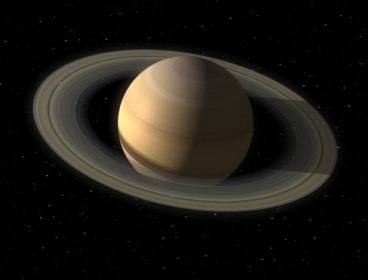Scientists announced discovery of molecular oxygen ions (O2+) in the atmosphere of Dione, one of Saturn’s 62 known moons, science daily reported Friday.

The discovery, made by NASA’s Cassini spacecraft, suggests that oxygen and other ingredients for life may be abundant on icy celestial bodies, according to a study by Los Alamos National Laboratory scientists and international research team.
“…together with similar observations of other moons around Saturn and Jupiter -- these are definitive examples of a process by which a lot of oxygen can be produced in icy celestial bodies that are bombarded by charged particles or photons from the Sun or whatever light source happens to be nearby,” says Las Alamos researcher Robert Tokar.
Dione orbits Saturn at roughly the same distance as our own moon orbits Earth. As it orbits Saturn every 2.7 days, the 700 mile-wide moon is hit by charged particles (ions) emanating from Saturn's very strong magnetosphere, including oxygen.
Molecular oxygen ions are then displaced into Dione’s atmosphere, after which they are stripped from the moon’s exosphere by Saturn’s magnetosphere.
A sensor aboard the Cassini spacecraft called the Cassini Plasma Spectrometer (CAPS) first detected the oxygen ions in Dione's wake during a flyby of the moon in 2010.
Tokar says the oxygen level in the icy moon is about the same level as one found in Earth’s atmosphere at an altitude of 300 miles, and is not enough to sustain life.
However, the existence of oxygen brings about more exciting possibility that on a moon with subsurface water, such as Jupiter's moon Europa, molecular oxygen could combine with carbon in subsurface lakes to form the building blocks of life.
From News reports
<관련 한글 기사>
토성의 달에서 산소 발견되다!
미국 항공우주국(NASA)의 탐사선이 토성의 위성 중 하나인 다이오네(dione)에서 분자산소 이온을 발견했다고 사이언스 데일리가 2일(현지시간) 보도했다.
로스 알라모스 국립 연구소가 발표한 보고서에 따르면 탐사선 카시니가 다이오네를 지나가던 중 산소이온을 감지했다고 한다.
보고서의 저자 중 하나인 로버트 토카르는 이번 발견이 우주로부터 태양 광자, 또는 에너지입자들이 천체의 얼음표면과 충돌해 대기권으로 산소를 방출하는 과정을 통해 얼음 천체에 산소가 생긴 실례 중 하나라고 말했다.
지름이 1120킬로미터에 불과한 다이오네는 암석으로 이루어진 중심부를 울퉁불통한 얼음층이 둘러싸고 있는 구조로 이루어져 있으며 토성과의 거리는 지구와 달과의 거리와 비슷하다.
다이오네가 행성 주위를 공전하는데 2.7일 정도가 걸리는데, 이 기간 동안 토성의 강력한 자기권에서 분출되는 무수히 많은 이온입자들이 위성을 강타하게 된다. 이 입자들이 다이오네의 지표면과 부딪히면서 다이오네의 얇은 대기권 내에 산소 분자들을 분출한다고 과학자들은 추정하고 있다.
이렇게 생겨난 산소 분자들은 곧 토성의 자기권에 이끌려 다이오네의 외기권에서 이탈하게 된다.
토카르는 현재 다이오네에서 발견되는 산소의 양이 지구의 480킬로미터 상공에서 발견되는 산소의 양과 비슷하다며, 이는 생명체를 지탱하기에 충분치 않다고 밝혔다.
그렇지만 목성의 위성 유로파(Europa)와 같이 지표면 아래에 물이 존재하는 위성에 이러한 과정을 통해 산소가 주입될 경우, 산소분자와 지하 호수의 탄소가 결합하여 생명이 생겨날 가능성도 있다.




![[Music in drama] Rekindle a love that slipped through your fingers](http://res.heraldm.com/phpwas/restmb_idxmake.php?idx=644&simg=/content/image/2024/05/01/20240501050484_0.jpg&u=20240501151646)

![[New faces of Assembly] Architect behind ‘audacious initiative’ believes in denuclearized North Korea](http://res.heraldm.com/phpwas/restmb_idxmake.php?idx=644&simg=/content/image/2024/05/01/20240501050627_0.jpg&u=20240502093000)




![[KH Explains] Will alternative trading platform shake up Korean stock market?](http://res.heraldm.com/phpwas/restmb_idxmake.php?idx=644&simg=/content/image/2024/05/01/20240501050557_0.jpg&u=20240501161906)






![[Today’s K-pop] Stray Kids go gold in US with ‘Maniac’](http://res.heraldm.com/phpwas/restmb_idxmake.php?idx=642&simg=/content/image/2024/05/02/20240502050771_0.jpg&u=)